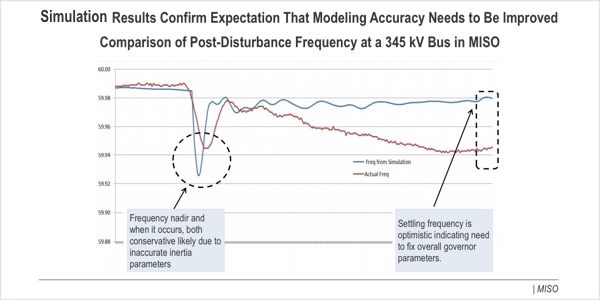By Amanda Durish Cook
MISO is seeking stakeholder input on how to address declining frequency response capability within the RTO.
“Frequency response has deteriorated in the Eastern Interconnection over the years,” Michael McMullen, MISO director of regional operations, said at the Jan. 5 Reliability Subcommittee meeting. “It’s currently adequate, but we want to make sure it doesn’t get any worse.”
System operators must maintain the grid at a frequency of 60 Hz in order to maintain network stability. An uncontrolled drop in frequency increases the threat of cascading blackouts.
The RTO says it needs better modeling and is considering more in-depth data collection to support its efforts to improve response to frequency disturbances.
“There is something in the model that isn’t right,” McMullen said, adding that stakeholder involvement is “critical” to more accurate modeling.
McMullen said that MISO’s current post-disturbance modeling is too conservative in estimating the occurrence and length of frequency dips because of its reliance on inaccurate inertia parameters, which factor in the collective ability of generators to automatically respond to frequency changes based on the pull of load. Simulations show the system recovering too quickly when compared with real events, indicating “a need to fix overall governor parameters,” McMullen said.
MISO currently measures the frequency response of every generator within its system at 24 seconds and 60 seconds following a deviation by polling a megawatt change in output per 0.1 Hz of a frequency deviation. McMullen said the RTO could collect more measurements, including collecting frequency values themselves in addition to megawatt output, gathering data more frequently at two- to four-second intervals and cataloging local balancing authority and MISO frequency response events in order to identify trends.
Hwikwon Ham, a staffer with the Minnesota Public Utilities Commission, asked if the effort would require major software changes, or if the RTO simply needs to capture more data for better frequency response modeling.
Gathering more data is the first step in determining whether program improvements are needed, McMullen said.
“It’s getting enough data to be able to talk with entities,” he said.
MISO is also exploring incorporating its phasor measurement units — devices installed across the Eastern Interconnection to measure the electrical waves on the grid at a specific point in time — in the effort. Those devices can isolate a frequency event and identify specific responses by generators, although their use for model validation is currently in the “embryonic” stage.
The RTO is continuing its efforts to capture data and correlate the numbers to a disturbance, McMullen said. It must also work on providing phasor measurement unit data to member companies.
MISO agrees with FERC’s recently proposed rule mandating that all new resources connecting with the grid have frequency response capability as a precondition for interconnection, McMullen said (RM16-6). (See FERC: Renewables Must Provide Frequency Response.) However, he noted that the new rule is not tailored to an energy market and does not propose any compensation mechanisms for providing frequency response.
MISO Consulting Advisor Terry Bilke said MISO consistently performs above NERC’s frequency response standard (BAL-003-1).
“We don’t anticipate any frequency problems as long as there’s not a change in fleet,” Bilke said. “The [Notice of Proposed Rulemaking] requiring new interconnection agreements to [have a governor] will ensure there’s no backsliding.”
Responding to a request by RSC Chair Tony Jankowski that MISO release its 2016 frequency response data, McMullen said the RTO must first determine what information can be shared publicly.
In 2015, MISO met NERC’s frequency response requirement at an average of -475 MW/0.1 Hz, more than doubling the NERC obligation of -211 MW/0.1 Hz. Still, the results were not as good as in 2014. (See “MISO Frequency Response Doubles NERC Requirements,” MISO Reliability Subcommittee Briefs.)
McMullen said he would update the subcommittee on MISO’s progress on the matter in April.





